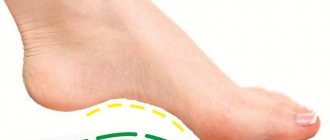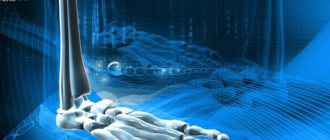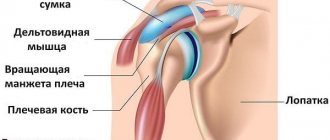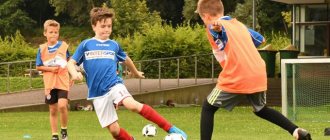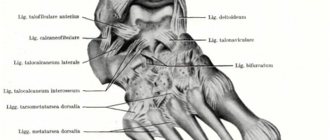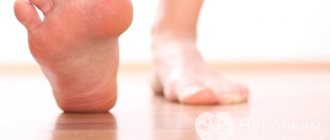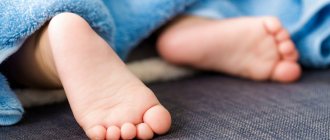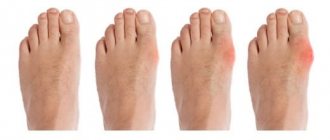Author of the article: Eduard Svitich - orthopedic traumatologist
Flat feet are the most famous foot deformity among dozens of others. It is with it that problems of the foot, ankle, knee and hip joints, and spine are often associated. So what is it and why does pathology have such a strong effect on the entire body? One of the main functions of a healthy foot is shock absorption. Among all other mechanisms, the most active shock absorber is the springiness of the arches. These rises are formed by groups of bones and ligaments that change their position under load and dissipate the energy of impacts on the surface.
Drug therapy
Medicines are used to relieve unpleasant symptoms. They cannot cure the disease.
A doctor should prescribe medications, as they may have contraindications. In addition, prescription medications may be prescribed if necessary. The doctor may prescribe:
- non-steroidal anti-inflammatory drugs (Diclofenac, Ibuprofen) – relieve pain;
- muscle relaxants (“Mydocalm”, “Sirdalud”, “Tolisor”) – relieve muscle spasms and eliminate cramps.
Is it possible to cure flat feet in an adult?
Organs and tissues change more easily under external influences while the body grows. Once the cartilaginous growth zones are closed, the shape of body parts cannot be significantly affected. Therefore, it will not be possible to significantly increase the height of the arches in an adult without surgery. By the way, the vast majority of diseases in adults cannot be treated. Only diarrhea or a cold goes away on its own. Hypertension, allergies, diabetes, arthrosis, glomerulonephritis, heart disease, flat feet can be controlled and “put to sleep”, but not completely eliminated.
And the phrase “flat feet cannot be cured” only means that an adult does not yet have the opportunity to make his feet taller. But this does not mean that nothing needs to be done about flat feet. After all, the problem is not the flattening of the arch, but the loss of shock absorption, without which all organs of the body suffer.
Physiotherapy
The central place in the treatment of flat feet is occupied by physical therapy, as it eliminates the causes of deformation. Particular attention is paid to exercises to strengthen the muscles, ligaments and bones of the lower extremities, which should be performed barefoot. It is necessary to rotate your feet, stretch out your toes, bend your toes, roll a ball with your feet, pick up small objects with your toes, walk on your toes, heels, and the outside of your feet.
A set of exercises should be selected by a doctor, taking into account the type, stage and degree of pathology, the patient’s age, the presence of other diseases, and general health.
To get the maximum effect, it is advisable to do gymnastics 2-3 times a day. No interruptions should be allowed. Additionally, you can do yoga and dancing.
Therapeutic exercise tones muscles, strengthens muscles, increases range of motion, activates blood circulation, and strengthens the immune system.
What is flat feet?
Flat feet is a decrease in the height of the arches due to a number of reasons. There are several classifications of flat feet. There are three stages of the disease and several types. In order to understand the prognosis and features of the approach to flat feet, it is worth knowing its main varieties:
- Pathological flatfoot. Also called rigid or immobile, anatomical. A form that is painful and brings a lot of discomfort. Occurs due to congenital causes or after fractures of the bones of the foot and leg. Definitely requires active intervention at any age.
- Physiological flatfoot. It is a period of development for any healthy child. It is observed for up to 4–6 years and does not require treatment. Preventive measures are recommended: massage, proper shoes and insoles.
- Elastic planovalgus or flat foot in adults. "Stumbling block" of orthopedics. Just a couple of years ago, this condition was considered a serious pathology; today they often talk about the relative safety of the condition. Whether this is true or not, we will discuss below.
How does the human foot develop?
The “adult” shape of the foot is the result of the long-term influence of many factors. The formation of tissues of the musculoskeletal system occurs in utero, but their active change continues throughout life. Here's what affects foot shape, strength, and balance the most:
- Genetics. We are almost 70% genetically programmed. And only the remaining 30% can be somehow influenced. Even if congenital bone deformation was not recorded in the family, hereditary weakness of ligaments or muscles, the position of the bones of the lower leg and thigh, play a role.
- Muscle tone and nervous system after birth. Hyper- or hypotonicity disrupts the development of the foot and leads to deformities.
- First shoes. Shoes are the leading cause of foot pathologies. And shoes are of the utmost importance in childhood, when the foot is especially pliable.
- Body mass. All our organs are genetically “sharpened” for a certain load. Exceeding the reserve strength of tissues leads to their changes.
- Sports loads. Lack of physical activity weakens the muscles and prevents healthy feet from developing. Excess or too early activity also leaves a negative imprint on the musculoskeletal system.
What to avoid with transverse flatfoot
To prevent complications when diagnosing transverse flatfoot, you should avoid:
- standing on your feet for a long time;
- intense sports;
- strong physical activity;
- wearing flat-soled shoes (heels 3–4 cm high are required);
- using other people's shoes, since each person has an individual foot shape;
- wearing models that are the wrong size (small, large, narrow or wide);
- shoes with a platform, wedge and very thin soles;
- constantly wearing sports models;
- shoes that do not have backs, but only thin straps (the foot must be secured).
Most often, transverse flat feet affect the fair sex, not men (8:2), and this is not at all surprising, since women wear narrow stilettos for several hours in a row every day. Thus, in pursuit of beauty, ladies forget about their own health.
How to avoid arthrosis if you have flat feet
Flat feet today are easily corrected with the help of orthopedic insoles and special shoes. With arthrosis, the situation is more complicated: the disease has no cure and tends to progress. Therefore, if you have a deformed foot, remain vigilant so as not to trigger the disease. What can you do?
- Avoid wearing tight shoes or high heels except occasionally.
- It is no coincidence that orthopedists and rheumatologists recommend losing weight. If you have extra pounds, the heel bone deforms faster, as do the joints of your toes. Heart function deteriorates, coxarthrosis and gonarthrosis, spondyloarthrosis, and other diseases develop. Therefore, reconsider your diet and physical activity.
- Try not to overexert your feet. Change positions more often, do not squat, do not cross your legs.
- Take part in safe exercise, such as walking or swimming.
- Walk barefoot on grass or sand more often - this is an excellent prevention of arthrosis with flat feet.
Arthrosis is a serious and dangerous disease. If there is a history of flat feet, the situation becomes more complicated, but by no means becomes hopeless. Reconsider your lifestyle and habits, take care of your joints - and they will serve you faithfully for many years!
Treatment methods for transverse flatfoot
Recently, people aged 23–56 years have been turning to doctors with complaints of leg fatigue, swelling, pain and bone growth on the foot. However, treatment of longitudinal and transverse flatfoot is prescribed to each patient individually depending on the symptoms, degree and severity of the disease.
- Therapeutic correction.
It is used at the initial stage of development of pathology and involves the use of medical devices, for example, for an inflamed metatarsophalangeal joint, correction is performed with rollers. They are placed between the second and thumb and are fixed to the side, thereby restoring the anatomical position.
If you have transverse flatfoot, you can also choose a device such as orthopedic insoles, which allow you to restore the physiological curve of the foot, reduce the load on the spinal column and ankle joint and stop the progression of the disease.
Often, orthopedic shoes are prescribed to support the foot, usually after surgery for severe cases of the disease.
- Drug therapy.
In this case, the patient is prescribed non-steroidal anti-inflammatory drugs (NSAIDs) based on Kerotolak, Indomethacin and Diclofenac, which are aimed at eliminating pain in muscles and joints. In case of severe discomfort and inflammation, intravenous or intramuscular administration of drugs is prescribed.
- Exercise therapy and physiotherapy.
These methods are used as an adjunct to the main treatment of transverse flatfoot in adults. Most often they are prescribed at the first and second stages of the disease, as well as after surgery during rehabilitation.
Physiotherapy is used in the presence of inflammation and includes the following activities:
- electrophoresis;
- mud baths;
- shock wave therapy (UHF).
Thanks to physiotherapy, joint mobility is restored, metabolic processes and microcirculation in muscle tissue are improved.
Shock wave therapy is used to destroy microscopic crystals of calcium salts deposited in tendons, joints and ligaments, as well as to launch regenerative processes in cells and the rejuvenation mechanism. This procedure is very effective in relation to cartilage and bones, since it has a positive effect on them without causing harm to the muscles. In addition, it improves blood flow, that is, it increases it, restores ligaments that help cope with stress on the foot.
Electrophoresis using calcium ensures the delivery of the element to the bones. This procedure is carried out because in tablets or injections it is not always well absorbed by the body.
Heat therapy is also prescribed using paraffin-ozokerite applications, which warm up the disturbing area, eliminate pain, improve metabolism and increase immunity.
- Surgical treatment.
The most effective way to restore the anatomical structure of the foot with transverse flatfoot is surgery. It is carried out in order to redistribute the tendons and muscle tractions responsible for the position of the toes. In some cases, this requires removing a fragment of bone tissue (with valgus transverse flatfoot).
Treatment of flat feet in adults
Here, as in all developed countries, it is not elastic flatfoot itself that is treated, but its consequences. Normalizing the position of the foot, improving its sensitivity and eliminating overload improves health and makes movement comfortable. The most effective options for helping flat feet are:
- Orthopedic insoles. Arch supports stimulate the muscles and relieve the load on the foot. The best conservative treatment for corns, pain, and foot deformities. Individual insoles that are made exactly according to your print work great.
- Exercises. Special complexes relax spasmodic muscles and strengthen hypotonic muscles. Since a flat foot affects all parts of the body, it is also necessary to work on all parts of the movement apparatus.
- Massage, reflexology, kinesio taping. Additional treatment of symptoms of flattening: pain, fatigue, limitation of movement. Improve blood flow and sensitivity, relieve pain.
Medtechnika Orthosalon stores are professional salons of orthopedic goods. Our specialization is the best products for correcting flat feet: arch supports, massagers, tapes and exercise equipment. Consultants are ready to answer any questions, and there is a convenient online store.
With us you can also use the service of individual custom-made insoles:
Effective exercises for transverse flat feet
Exercises specially designed for people suffering from this disease are more effective in combating transverse flatfoot in adults. They allow you to strengthen muscles and stop the development of the disease.
Exercise therapy helps improve tissue tone and improve blood flow in the lower leg. The complex must be selected in such a way that the effect occurs on several muscle groups of the foot at once. These are exercises from various positions (standing, sitting, lying down) using small objects, a gymnastic stick and inclined planes.
For each patient, the course of classes is selected individually depending on the type of pathology and its severity. Therefore, it is necessary to begin implementation only after consultation with a specialist, namely an orthopedist, who will offer exercise therapy specifically for you, so that it is effective for the development of the muscles and ligaments of the ankle.
To get the maximum results from the exercises, they should be done in the morning, since at this time the muscles are not yet tired. Moreover, it is necessary to start with small loads and gradually increase them. It is advisable to repeat the complex two to four times a day.
- Starting position – lying on your back.
Lie on the floor face up, legs slightly apart. Next, the toes must be squeezed and unclenched for two minutes.
The position is the same as in the previous exercise. The movements in this case are made not with the fingers, but with the feet. They should be rotated first clockwise, then counterclockwise.
You need to pull the toes of your feet towards your head. This can be done with each leg separately or with both legs at once.
The lower limbs in this exercise should be spread and bent so that the soles of the feet touch each other. Next, leaning on your feet, you need to try to make clapping movements with your heels, but at the same time your toes should not separate.
- Exercises while sitting on a chair.
Make a fist with your right hand and place it between your knees. At this time, the foot is placed on the edge, that is, the inner part is raised from the floor, and the outer part, on the contrary, is pressed.
Place your hands on your knees, after which you need to lift the heels of your feet, while leaning on your toes. This exercise must be performed first with both legs, then alternately.
Now you should do the opposite, that is, it is not the heels that are raised, but the toes of the feet. The starting position is the same.
Place small items on the floor. You need to collect them all using only your toes, that is, hold the thing with them and, holding it, pass it into your hand.
The next exercise is to make movements with your feet that resemble a caterpillar crawling forward. It is necessary to bend your fingers and, leaning on the floor, move forward.
- Exercises in a standing position.
Standing on the floor, you first need to rise on your toes as many times as you can, and then do the same, but lifting the heels of your right and left legs alternately.
The exercise involves lifting your toes off the floor and standing on your heels. You should do this as much as you can.
In the same starting position, that is, standing exactly on the floor, you need to rise on your toes and, while maintaining balance, perform half squats.
What symptoms indicate that you have arthrosis and flat feet?
The problem can be recognized by the following signs:
- foot pain;
- swelling;
- tired legs;
- change in gait;
- curvature of the bones of the foot.
At first, the pain appears sporadically. Then it intensifies and manifests itself even at rest. Pain from the foot is transmitted upward - to the lower back and hip joint. After a night's rest, a person experiences relief.
After active movement, swelling occurs on the foot. To get rid of pain and discomfort, you have to rest for several hours. It becomes increasingly difficult to squat and maintain balance as the midfoot gradually expands.
If flat feet and arthrosis of the ankle or knee progress, the gait changes. From the side, a heavy gait and club feet are noticeable. Posture is disturbed - problems with blood circulation and new diseases of other systems and organs arise.
Flat feet lead to a whole chain of problems
How does flatfoot develop?
The human foot is unique: it springs due to its design.
The foot has two arches: transverse, which is located between the bases of the toes, and longitudinal, which runs along the inner edge of the foot. The arches of the feet are supported by a system of ligaments and muscles. Not a single animal, not even a kangaroo, has a springy foot. A healthy foot helps a person maintain balance and reduces shaking when walking. If the musculo-ligamentous mechanism of the foot weakens, the foot becomes flat and does not absorb the load. This is how flat feet arise.
How to independently determine the presence of flat feet
In addition to identifying symptoms characteristic of the disease, you can additionally conduct a simple test at home for the purpose of tentative diagnosis. Lubricate the sole of the foot with any coloring substance, for example, fatty cream. Place a sheet of white paper on the floor and leave your foot print on it. The main thing is that the load on the foot is uniform, that is, you need to stand in your normal position, without deviating to the side.
Using a pencil, draw a parallel line from the heel to the big toe and another line perpendicularly - from the deepest neckline to the outer edge of the foot. Next you need to evaluate the print. If it occupies half or more of a perpendicular line in the area of the narrowest part of the foot, this may indicate the presence of flat feet. The norm in children and adults is different, so this test in children can indicate the normal development of the structure of the foot.
Causes of flat feet
- excess weight (causes flattening of the longitudinal and transverse arch);
- genetic predisposition;
- “wrong” shoes (high heels, narrow toes);
- physical inactivity.
How do you know if you have flat feet?
You should definitely pay attention to your feet if you notice the following alarming symptoms:
- excessive leg fatigue after a long walk;
- swelling;
- feeling of heaviness in the legs;
- burning;
- numbness of the legs;
- lower back pain;
- feeling of coldness in the legs;
- pain in the arch of the foot from the heel to the toes;
- bruises on the sole;
- the occurrence of calluses and corns.
Diagnosis of transverse flatfoot
Flat feet can be either congenital or acquired. In addition, it varies in degrees:
- Mild transverse flatfoot (1st degree). In this case, the deviation of the thumb is no more than 19°. The patient feels weakness in the legs, there is slight swelling.
- 2nd degree of transverse flatfoot (moderate). The deviation of the thumb here can be up to 30°. The pain becomes stronger, the person finds it difficult to move.
- Severe transverse flatfoot (grade 3). The deviation of the thumb is more than 35°. Deformation of the foot, pain in the legs and lower back are observed. The person moves with great difficulty.
Regardless of age, the symptoms of the disease are the same, but only a specialist can confirm it. What methods will be used for treatment depends on what caused the pathology. Only a doctor can determine them, so you don’t need to diagnose yourself and carry out therapy yourself, otherwise you can only make things worse and cause complications.
- Diagnosis of transverse flatfoot using radiography of the feet.
During this procedure, the patient is in an upright position. In order to obtain more detailed information, photographs are taken from different angles. An x-ray is prescribed for transverse flatfoot only after examining the limbs, checking muscle reactions, taking into account the wear and tear of shoes and gait.
The specialist also conducts computer diagnostics, through which you can obtain information regarding the type of arch of the patient’s foot, as well as the load on it. This procedure allows you to find out which points are subject to excessive pressure from a person’s weight.
We recommend
Therapeutic massage for the back: features, indications and contraindications Read more
- Studying the foot using a stopometer, ruler, protractor, compass.
The method consists of calculating the podometric index based on data obtained by measuring the foot using instruments and studying the print on paper. Normally, the indicator should be in the range of 29–31. If the ratio of foot width to length increases and is more than 42, the patient is diagnosed with transverse flatfoot.
It is worth noting that with this disease, pathological changes can affect nerve fibers and blood vessels, so the doctor prescribes a consultation with a neurologist and phlebologist surgeon.
Massage for transverse flat feet
With the help of massage, you can get rid of symptoms of transverse flat feet such as pain, swelling of the feet and inflammation. In addition, it helps speed up lymph flow, improve blood flow, and tone muscles. The positive effect of massage can only be obtained if it is done regularly, that is, 12–15 minutes, 15 sessions per month.
Before starting the procedure, it is best to steam your feet in a bath with the addition of herbal infusion or sea salt.
Massage for transverse flat feet is done as follows:
- Warm up the skin on the legs and feet by stroking and rubbing.
- Using kneading, squeezing and tapping techniques, massage the calf muscles.
- Massage the soles of your feet thoroughly.
- Work the thumbs of the lower extremities.
This massage has a positive effect on biologically active points and allows you to get rid of transverse flat feet.
We recommend
Laser aesthetic cosmetology: perfect technology for an ideal appearance Read more
Transverse-longitudinal flatfoot, stages
Most often, a combination of transverse and longitudinal flatfoot in both feet is diagnosed. Unilateral damage is usually associated with various injuries. Symptoms vary depending on the extent (stage) of the disease.
- In the first, the ligamentous apparatus weakens, but the foot still retains its natural shape. During this period, a person feels the first unpleasant symptoms after prolonged stress on the legs in the form of burning, fatigue in the limbs, which disappear after rest. For some people, already at the first stage, the gait becomes less flexible.
- At the second stage, changes in the foot in the form of flattening of the arches are visible to the naked eye. It becomes wider, spread out, and in the area of the thumb you can notice a small protruding tubercle. The pain becomes constant, spreading above the foot to the lower leg and knee joint. The gait changes even more - clubfoot occurs.
- At the third stage, the changes are sharply expressed, which provokes degenerative-dystrophic lesions of the joints. The disease also affects the condition of the spine, especially the intervertebral discs, which can cause osteochondrosis, intervertebral hernias, and curvature of the spine. Pain in the limbs accompanies a person constantly and gets worse all the time. At this stage, a person’s performance decreases and even walking short distances causes difficulties.
Treatment with orthopedic shoes
Wearing orthopedic shoes is a must for patients with flat feet. These shoes are made specifically for the treatment and prevention of flat feet. Currently, orthopedic shoes come in different models and styles. You can choose any model to suit your taste. What should these shoes be like:
- Low heels up to 4 cm, but flat soles are prohibited. There must be a heel. This will provide conditions for the correct placement of joints and muscles.
- The shoe size must match the size of your feet. Clearly according to the parameters, so that it is not wider and not narrower. Otherwise there will be no therapeutic effect. The situation may even worsen, and flat feet will develop to the next degree.
- Mandatory fixation with a hard back.
“The ideal shoe should have a 3 cm heel, a flexible sole, a firm heel, a slight instep and made of leather, suede or nubuck” ©

